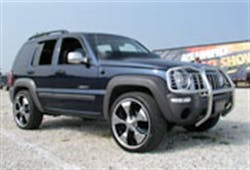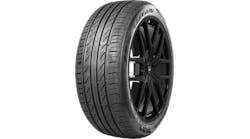Crossover confusion: The lines for light truck tires are blurring thanks to pickups, SUVs and hybrid vehicles. And it isn't getting any easier, say dealers and tiremakers
Defining "light truck" tires has become very complicated because the lines separating the different tire groups in this segment are blurred. There are P-metric light truck tires that are designed for commuter duty and LT tires designed for working trucks. Ultra-high performance light truck tires fill the performance void. SUV tires have to have the load carrying capacity of a light truck tire and the comfort of a passenger car tire.
Original equipment manufacturers have blurred the line even further by creating the crossover vehicle segment.
We talked with independent retail dealers and wholesale distributors from coast to coast to get a better handle on the light truck tire market in 2007. We also talked with several tire manufacturers and their engineers to get their points of view.
Basic definitions
P-metric light truck tires deliver a smooth ride, good traction and wear performance that will satisfy most buyers. Their vehicles are for commuter service and little else. These customers will be satisfied with a P-metric LT tire.
But if their egos are connected to their vehicles, they demand far more. For the upscale light truck/SUV segment; Lexus, Acura, Infinity, Porsche, Volkswagen, Cadillac, Range Rover, GMC/Chevrolet, Ford/Mercury/Lincoln, Dodge and other makes come fitted with UHP tires in plus sizes. These vehicle owners want the "look" and don't care about much else.
Some, but not all, of the UHP light truck tire manufacturers have added beef to their tires to better handle the higher loads plus service requirements such as towing trailers and boats. That's because their reduced sidewall eliminates air space in the tire, which, in turn, reduces load carrying capacity.
[PAGEBREAK]
True commercial work tires come with high ply ratings and may come in all-steel construction that will hold up under harder working conditions. They are designed to deliver a low cost-per-mile over their entire lifecycle. That is why many tire dealers have commercial sales professionals servicing customer fleets: To maintain the business, they must follow the tire from installation to the scrap pile and document the entire life of each tire.
1. Passenger/commuter service. "The biggest difference to customers is ride quality," says Mike Lofstedt of Lake Region Tire in Monroe, N.Y. "Unless they are working the truck hard, they will prefer a better ride.
"But there are times you will find yourself in between tire types. Like when a customer says he tows a boat. What do you sell him? Simple: a set of tires that will handle his real service requirements.
"Get the owner's manual out, check the vehicle placard and review the guidelines if you are unsure," he says. "As long as you equip the vehicle with the proper load-rated and speed-rated tire, the customer will never complain -- although, his wife might as she drives the kids to school and finds her smooth ride gone." Both performance and standard P-metric SUV and pickup tires make up about 75% of the light truck tire sales at Dolson's Tire in Middletown, N.Y. That number will increase, according to owner Ed Perry, who says more customers are buying crossover SUVs.
"OEMs are blurring the differences between LT and P-metrics. The reinforced or XL P-metric are less costly than LT tires and have a higher load rating than regular P-metrics, so consumers are buying them.
"About one-half of the pickup tires we sell are now P-metrics when a couple of years ago it was less than 20%."
Dolson's Tire does a lot of custom work with tire and wheel packages. "Someone that buys a new Yukon with factory 'plus-sizes' wants something different," says Perry. They don't want "to see another Yukon drive up with the same wheel and tire package. That is why we are seeing more standard tire and wheel stuff bought from the car dealer... then (the owners) come in for a complete switch. They want to have something unique and they are willing to pay for it."
George Bohorquez, president of Pioneer Tire Supply Inc. in Northern California, also sees more XL P-metric light truck tires, although commercial light truck tires represent 75% of his wholesale light truck tire sales. "Yet in the performance area, we are still selling performance light truck/SUV plus-sizes in several brands that represent a great deal of business to us."
Light truck tire sales are just about split between LT and P-metric light truck tires at another warehouse distributor, Corsi Tire in Westchester, N.Y.
[PAGEBREAK]
According to a company representative, OEMs dictate what tires customers will select, unless they have had very poor experience with them. That is especially critical when it comes to the load range.
Corsi's retail dealers say customers will not pay for an LT work tire when their light trucks came with P-metrics, even if they should have higher load tires. "I will not make any effort to try and switch a customer that is very specific about the tire brand wanted," says Lofstedt. "I'll find what they want if I don't carry that brand, or size, then I get them back in for installation. Why? Because they will not be happy with anything else."
2. UHP. When it comes to plus-size UHP tires for light trucks, sales decisions get far more complicated -- and risky for a dealer. Some OEMs will not warranty their vehicles if the tires are changed to any plus size. Yet, some owners want plus sizes up to 26 inches with custom wheels.
Michelin recognizes the popularity of plus sizing and offers some direction for tire fitment. "Given acceptable load index and speed ratings, we advocate specification of tires where the plus size outside diameter is within a 3% range of the OEM fitment," says Kip Newton, Michelin North America Inc.'s product category manager for on-road light truck tires.
"Changes in tire/wheel diameter can affect vehicle systems such as gearing, speedometer reading, traction and stability control. When there is any increase in tire/wheel outside diameter, the customer must be made aware of potential impact on vehicle stability."
"Larger 22-inch to 26-inch rims are an extreme, but a growing choice for the performance/style buyer," says Jim Johnson, director of technical services for Falken Tire Corp. "Tire loading and pressures must be maintained, regardless of the tire rim size, to ensure safety.
"When it comes to alignment, plus sizes can cause tires to wear on the shoulders or cup or have other abnormal wear patterns. If this is noticed make sure the vehicle is aligned to new specifications to correct this. Factory settings simply may not fix the dynamic action of the suspension with plus-size tires."
Bill VandeWater, consumer products manager, sales engineering, for Bridgestone Firestone North American Tire LLC, suggests dealers check both the tables in the Tire & Rim Association manual and the placard on the driver's door when plus-sizing. "Make sure everything clears and there will not be rubbing or interference during loaded operation. This includes backspacing and width of the rim. Make sure the tire is inside the wheel well with the tires pointed straight ahead."
[PAGEBREAK]
"Before you fit a SUV or light truck with plus-size wheels and tires, make sure you make the buyer aware that the handling may be vastly different and ride harshness and comfort will be compromised," says Melissa Montisano, general marketing manager, light truck tires for Goodyear Tire & Rubber Co.
3. Commercial light truck/work tires. Commercial light truck tires are on the bigger pickups such as F-250, F-350 and F-450-Super Duty Fords and vans and equivalent Chevrolet/GMC, Dodge, Tundra and Nissan full size pickups. Generally, the one-half-ton trucks come with P-metric tires, but some three-quarter-ton pickup trucks also feature OE P-metrics.
"We are no longer selling all-steel light commercial tires," says Bohorquez from Pioneer Tire. "Buyers simply do not want to pay $300 each. The fact that they last longer, can be retreaded and deliver better fuel mileage isn't as important to small fleets as out-front cost. Larger fleets will pay the price, and they generally have a national buying contract with one of the major manufacturers."
Price isn't as important on the East Coast, says Perry of Dolson's Tire. "When a real commercial customer comes in and wants a tough, long-wearing tire, we generally send them away with the Goodyear Unisteel, which is 100% steel construction. They last longer, can be retreaded and, although they are about $300 each at retail, the long-wearing benefits (cost is two times greater but wear is three times greater) make them a better buy for people with working fleets. They understand life-cycle-costing and are quality buyers."
According to tire manufacturers, working tire sizes are more standardized. Most are high load-rated at 14 to 16 plies.
Basic training
"Having a well trained dealer and sales staff, plus knowing what questions to ask, has never been more important," says Bridgestone Firestone's VandeWater.
"Unless the sales staff asks about service, towing, people loads and even performance expectations it is impossible to get it right for a customer." For example, every new vehicle on the road that is capable of towing has a detailed set of guidelines in the owner's manual that explain gross vehicle weight (GVW) and the maximum towing allowed (GVW and gross combined vehicle weight) in pounds. But first you have to determine how much weight the actual towing will entail before replacing the tires.
Falken's Jim Johnson says knowing the constructions and technology in a tire is very important, "but it is clear that not all tires in the same rating and size are alike. The government regulates what the tire must be built to do, but each manufacturer determines how they do it."
[PAGEBREAK]
Goodyear's Montisano says P-metric sizes typically operate at 35 psi, while LT tires can operate at higher pressures, often between 50 to 65 psi and in some cases up to 80 psi. (According to Tire & Rim Association standards, LT and P-metric tires typically carry the same load, but the LTs operate at higher pressures. "Two tires of the same size can be found in P-metrics and LTs, but the LTs are generally built for hard work, not just commuter duty.")
"P-metric light truck tires typically use a one- or two-ply-rated sidewall construction and classic two steel belts under the tread," says Michelin's Newton. "LT tires often use reinforcement such as sidewall thickness, three-ply-rated sidewalls or extra belts.
"Although ply rating terminology has been carried over from the bias-ply technology, where the rating actually represented the actual number of plies in the tire, it is still used throughout the industry to this day."
OE tires
When tire manufacturers start with new vehicle concepts for an OEM and are able to develop tires specifically for the operational parameters of those vehicles, their jobs are easy. They can create a new tire for a given vehicle that is cost-conscious, performance-specific and will work under a broad spectrum of service requirements.
When that vehicle needs replacement tires, however, the OE tire might not be available to a retail dealer. According to Lofstedt, that has happened to him with two of the tire companies he represents.
"There are times a customer hated the OE tires and asked me recommend a better tire for their vehicle. This is when a real opportunity starts."
Looking into the future
"The future at the OEM level is clear, larger rim diameters and smaller aspect ratios are here to stay for the next three to five years," says Montisano. "Total SUV and light truck vehicle sales will continue to grow with the emergence of the crossover SUV (CUV) market.
"The size of some vehicles, particularly the light truck segment, will continue getting larger, so tire sizes will need to handle greater loads. P-metrics will move more to XL, and LT sizes will move to the E-Load Range. Speed ratings will also increase."
Nick Fouseks, Falken Tire brand manager, says tires will get bigger. "The 16-inch and 18-inch OEM tires will continue being changed to 20-inch UHP tires, and then 22-inch to 26-inch UHP tires will get more and more popular. Our products, like the STZ-04, are already developed for higher loads and are on the market today. We will also have some very interesting new tires by the SEMA Show 2007." VandeWater says the UHP/light truck plus-size tires will grow in popularity, "and the OEMs will be using them from the factory. The volume in 22-inch and 24-inch will start getting really important in the aftermarket."
[PAGEBREAK]
There also will be growth in the 32-inch and 42-inch tire segment because lift kits and "off-road action" are still growing, he says. "We also expect that run-flat tires will start being accepted in this segment, probably not for fleets right away, but on SUVs, CUVs and light-duty pickups used by consumers/commuters."
Newton says Michelin expects “to see a rapid shift from traditional light truck/SUVs to CUVs."
About the author
John Newman is a freelance writer based in New York.
A 'loaded' question
Modern Tire Dealer asked several tire dealers if their customers understood the load limits/load indexes as they concern their vehicles. Generally, they don't seem to.
"Very few of our retail customers understand these factors," says George Bohorquez, president of Pioneer Tire Supply Inc. in Northern California. "They might be towing a big trailer or a boat, but they still replace tires with the P-metrics when they should be going to at least an XL."
"Eliminating customer ignorance can raise the ticket price as well as give the customer a safer vehicle," says Mike Lofstedt of Lake Region Tire in Monroe, N.Y. "The LT price factor is only a slight increase over P-metrics, and the safety benefits to the customer can be very important."
The 2007 Tire & Rim Association Yearbook contains all the technical specifications and tables regarding load carrying capacity. For more information, visit www.us-tra.org/traHome.htm.
[PAGEBREAK]
Light truck and SUV sales are expected to rebound: Crossover vehicles remain big sellers
By Mike Manges
Last year wasn't the most robust one in the history of the light truck tire segment. According to Modern Tire Dealer's 2007 Facts Issue, replacement LT tire shipments were down 4.1% compared to the previous year, while OE shipments fell 25.7%. P-metric tire shipments also were down.
Total light truck sales (domestic and import) in the United States dropped 6.2%. Sales of light trucks made in the U.S. really took a hit, falling nearly 10%. Some of that can be attributed to gas prices that spiked to $3 a gallon last summer, says Travis Roffler, Continental Tire North America Inc.'s director of marketing.
"If you segment the market out, the drop was in large SUVs like the Expedition, the Tahoe and the Yukon. But now that gas has dropped down to $2 a gallon, I think we'll see a recovery in light truck sales."
So far, his prediction seems to be on the money. General Motors Corp. reports that its full-size pickup truck sales in January increased 7% over January 2006 sales. Sales of its Chevrolet Avalanche model rose a whopping 77%.
Meanwhile, sales of crossover vehicles -- many of which use P-metric tires -- remain robust.
"Even though the (auto) industry had a little bit of a downturn in 2006 in full-size pickup trucks, we've seen that downturn has been picked up by crossovers," says Melissa Montisano, general marketing manager, light truck tires, for Goodyear Tire & Rubber Co.
Montisano classifies crossover vehicles as a category within the greater SUV segment.
"We view SUV as three different sub-segments: entry level, mid-level and premium. Crossover owners have a different perspective of what their vehicles are."
Demographically, pickup truck and SUV owners are more easily identifiable than crossover vehicle owners, she says.
"The pickup truck customer is looking for a tire with a rugged exterior -- something that's durable. But they also are looking for a quiet ride. The SUV driver isn't looking for any type of off-road capabilities; they're looking for traction.
"You can't put crossover drivers in a general pool. It's how they view the vehicles that they're driving."
John McDonald, a spokesman for General Motors Corp., says GM expects 2007 to be a good year for pickup truck, SUV and crossover vehicle sales.
Sales of GM's Saturn Outlook, GMC Acadia and Buick Rendezvous crossover vehicles shot up 125% from January 2006 to January 2007, he says.



